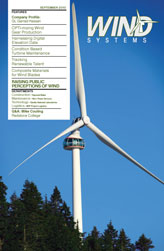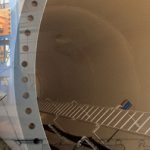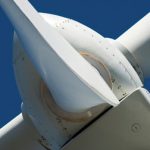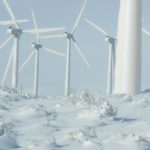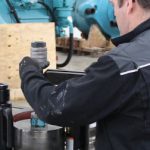Across the United States, the wind energy sector is primed for tremendous growth. More states have set renewable portfolio standards, and with the oil spill disaster in the Gulf of Mexico the federal government is poised to pass meaningful energy legislation that could include a tax on carbon dioxide emissions.
The move to a new energy economy offers a lot of positive outcomes such as lessened dependence on the grid, more sustainable business activities, and a host of new jobs. To meet these opportunities America’s workforce, like its energy economy, will need to be retooled to meet the growing demand for skilled labor in wind and other energy-producing sectors.
A January 2009 report delivered by the Council of Economic Advisers found that the clean energy investments of the American Recovery and Reinvestment Act (ARRA) are not only creating jobs today, but for the future. The clean energy provisions of ARRA alone have already saved or created 63,000 jobs and are expected to create more than 700,000 by 2012.
Clean energy jobs, according to the ARRA, are defined as new work for skilled laborers who can install efficient heating and cooling systems and windows, retrofit homes to save electricity, and can build and install solar panels, wind turbines, and other clean energy technologies. These investments are positioning the American workforce to remain competitive and keep our nation at the forefront of a new low-carbon global economy. At the same time, these initiatives are changing the way that we produce, distribute, and use energy to reduce green house gas emissions and cut our dependence on foreign oil [1].
To better understand where the wind industry is headed and how to meet the increasing job demand, Ecotech Institute spoke to three members of its board of advisors who specialize in the wind energy sector and helped develop the school’s curriculum. Those weighing in on the industry’s potential and the demand for talent include Abbas Ghassemi, Ph.D., director of the Institute for Energy and the Environment, WERC executive director, and professor of chemical engineering at New Mexico State University; Al Zeitz, director of North American Operations at the DeWind Co.; and Colin Coyne, managing principal of the Coyne Group, LEED 2.0 accredited professional and lecturer of sustainable enterprise at the Kellogg School of Management on “Sustainable Strategy.”
Setting the Stage
According to the American Council on Renewable Energy (ACORE), the anticipated increase in wind power energy by 2040 will be significant, as much as a tenfold increase when compared with today’s production and consumption. In addition, a study released in February 2010 by Navigant Consulting, Inc., found that the number of renewable energy jobs would more than double by 2025 if the nation adopted a plan to require 25 percent of its electricity from renewable sources. Several states currently have renewable portfolio standards, and the trend is continuing.
“As we approach global peak oil in the next 25 years, optimistically, we must be able to diversify into the many sources available in order to sustain energy production that will allow our economy to grow without intermittent shortages, security vulnerabilities, extreme costs, or environmental degradation,” says Ghassemi.
Sourcing United Nations data, an increasing population is a considerable factor when looking at alternative energy demand. “With projected population growth exceeding 9 billion people by 2050,” he continues, “global energy consumption worldwide, as well as the estimated domestic demand, increases the need for production, availability, and delivery of energy from all renewable sources [2].”
According to Zeitz there are a number of reasons to anticipate growth in the wind industry, including its benefits as a clean source of electrical power and a good investment. “The development of wind energy for electrical power is growing more popular in the private sector,” he says. “Many people would like to see more wind turbines installed to generate electrical power.”
“In the past three years, worldwide wind power capacity has more than doubled,” Coyne adds. “This is largely due to wind power becoming a cost competitive alternative, especially when one considers that a wind plant is far less expensive to construct than a conventional energy plant. Of course, one can’t ignore the general demand for clean power. Certainly this debate will heat up with recent events in the Gulf of Mexico. New clean air standards will also accelerate demand.”
Demand for Talent
As with growth in any industry, skilled workers are essential to meet the demand. In the case of wind power, people must be able to know how to build and sustain tools, equipment, and technology.
Ultimately, this means jobs—which is obviously positive in a tough economy—but what kind of jobs will they be? Our experts underscored the increasing need for educated, skilled workers across the industry, and what they could be doing.
“There are many different kinds of jobs needed to support the growth of the wind industry,” says Zeitz. “However, the greatest number of jobs needed in the wind industry will be technicians. Wind turbine technicians are the backbone of the wind industry, and these technicians will be required to keep the growing fleet of wind turbines maintained.”
“From green power brokers to wind turbine technicians, the demand for jobs will be substantial,” Coyne says. “At a very pragmatic level, the demand for technicians to serve these new facilities will be great, as will attorneys and paralegals who understand the unique nuances of green power and green power incentives, real estate leases, and project financing.”
“To address the ongoing and emerging needs for installers, operators, managers, field crew, and supervisors, we should train individuals in mechanical and electrical fields specific to wind power,” according to Ghassemi. “As the ramp-up takes place, there will be significant growth in the manufacturing area for wind blades, structures, gearboxes, and associated hardware, emerging software, and technologies. There will also be a tremendous growth for individuals to maintain and repair gearboxes, energy storage devices, and utility service/integration functions.”
Creating Skilled Workers
Ecotech Institute, which recently opened its doors in Aurora, Colorado, was created to help fill this demand. The first and only school in the United States entirely focused on renewable energy and sustainable design, it offers a path for people interested in entering the green economy with the right education. Ecotech Institute offers seven associate’s degrees and a certificate program.
When asked about Ecotech Institute’s role in training future workers in the wind industry, the experts were excited about applicable job training, especially for wind technicians. “The wind companies are obviously adept at what they do. However, graduates of Ecotech will bring much needed, on the ground, pragmatic knowledge,” Coyne says. “The issue for wind companies is taking what has largely been small-scale or theoretical models and turning them into full-scale operations. This requires well-trained technicians who understand the engineering behind the technology, available in sufficient numbers, and grounded in the mechanical realities of wind power conversion.”
Ghassemi believes that Ecotech can help companies find and place “trained individuals to participate in this growth. Ecotech graduates will be able to fill the niche in all of the sectors, including manufacturing in several positions.”
“With the number of turbines that are currently installed, and those that are scheduled to be installed,” Zeitz says, “the greatest demand is for skilled technicians to commission, troubleshoot, and maintain them.”
An Enthusiastic Future
A look at the future is exciting for people inside and outside the field. With the potential to bring more sustainable choices to the marketplace and bolster new, diverse workforces, the wind industry offers promise. “We need to continue to be mindful of our energy availability, production, use, and delivery,” says Ghassemi. “While we need to have scientists and engineers doing their part in making this happen, job training is vitally important in completing the cycle and assists in providing the resources required for making renewable energy available.”
“So much of the alternative energy discussion has taken place at a global or strategic level,” says Coyne. “What has been ignored are the thousands of technical jobs that will turn these ideas into reality. To me, the opportunities of ‘green’ in 2010 are similar to those that surrounded the space program in 1969. Both were catalysts for a new generation of entrepreneurs.”
References:
1) Executive Office of the President-Council of Economic Advisers. The Economic Impact of the American Recovery and Reinvestment Act of 2009. Second Quarterly Report, January 13, 2010.
2) United Nations, World Population Monitoring, ST/ESA/SER.A/228, United Nations, New York; Energy Information Administration, Electricity, www.eia.doe.gov/fuelelectric.html.G. Stix, Scientific American.



















